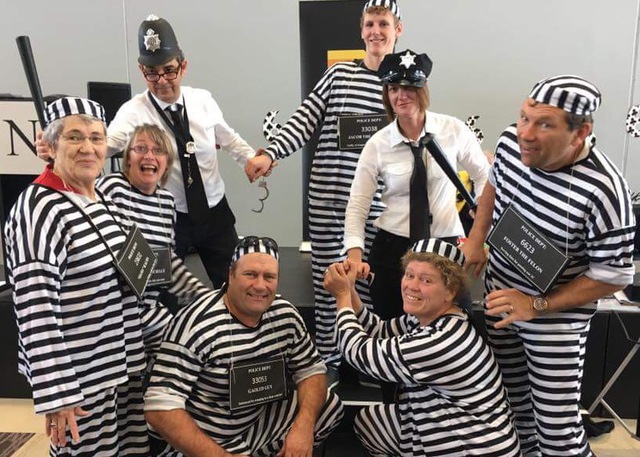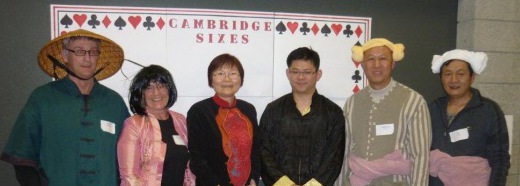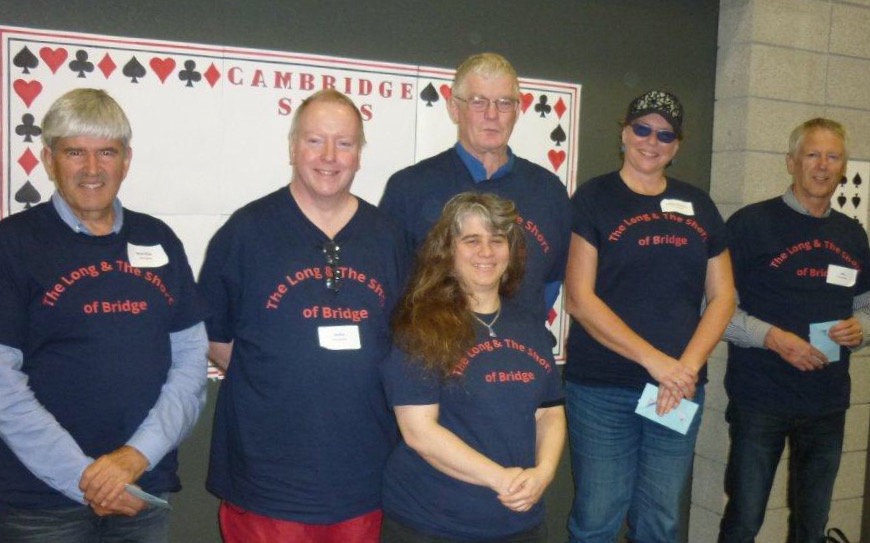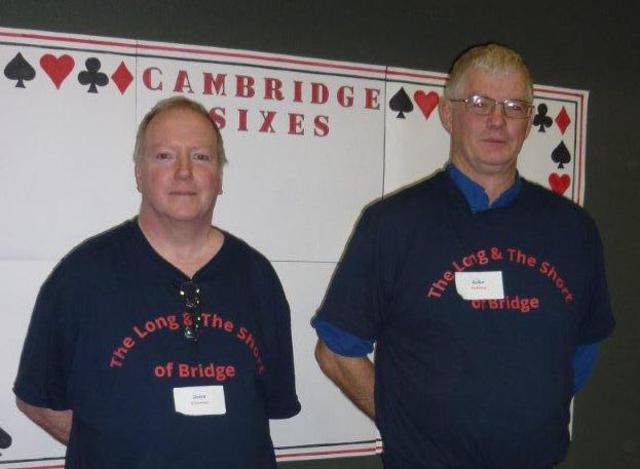August 2016 Newsletter
|
|
August is technically the last month of winter, and the season has rallied with lower temperature than we have been having so far, but no frosts so it feels like it is merely pretending. The Bridge Club continues to provide an amenable milieu to meet and mingle with others who play our beloved game. In this August edition of the ABC newsletter we bring you the ABC content, with articles by Stanley Abrahams, Hamish Brown, and Larry Cohen. We also bring you the usual bits and pieces from the committee, the office and the Club
From the Club: Grow The Club
The club is seeking suggestions from members for new ideas, or things to repeat for next year’s programme. If you have any feedback regarding things that have gone well, and you would like to see continue we’d also like to hear from you. This could be about the events, the premises, or ‘extra-curricular’ ideas, such as the fundraising quiz night, AGM attendance, Bridge Promotion etc…Have a chat with Ann or Deb, or better yet, send an e-mail with your suggestions / feedback
Openers Rebid of 1NT, Is it 15-17 or 15-16?
Stanley Abrahams
Does it matter?
The more I teach, the more I find out what is wrong with current methods.
There are 2 schools of thought on the question above, and at present the "Book" says 15-17.
Let us look at this from a simple point of view.
We need 25 points for game, and our partner rebids 1NT, showing 15-17.
If we hold 7 points we pass, as there is no way we hold 25 points
If we hold 10 points we can bid game, as we know there are 25 points.
So the question of what to do only arises when we hold 8 or 9 points.
Keep in mind opener does not know whether it is 8 or 9.
Our bid is 2NT asking opener to bid 3NT if they are not minimum.
So let’s look at the 3 responses when we hold 9 points.
15 points Pass. 16 bid 3NT, 17 bid 3NT. In each case we hold the correct number of points to either bid game or Pass.
Now let’s look at the 3 responses when we hold 8 points.
15 points Pass. 16 points bid 3NT. 17 points bid 3NT.
Note that in the second case we do not have the requisite number of points, only 24.
That is a failure rate of 1 sixth, or 16%.
Is this a major problem? Well sometimes we can still make 3NT with 24 points, there is no getting away from that, but clearly the bidding could be better.
-----------------------------------------------------
Now let’s look at the bidding when we play a rebid of 1NT shows 15-16 points, but not 17.
Well firstly we do not bid with 8 points, because we cannot hold 25 between us.
And if we hold 10 points we know that there are 25 points.
So the only time we ask the question with 2NT is when we hold exactly 9 points.
And if the answer is 15, we pass, and if it is 16 we bid game. Each time getting to the correct spot.
So clearly that is an improvement.
But what happens when we hold 17-18. Well our rebid is 2NT, not 1NT, and now with 8 points we can comfortably bid game, knowing there is a minimum of 25 points between the 2 hands.
But that is not all. 15-17 has a failure rate of 1 sixth, which is bad enough, BUT 15-17 also occurs 30% more often than 15-16, so that increases the failure rate up to 20%
Usually at this point in any discussion of various system changes I ask the important question.
What will it cost? Is there something we have lost if we change from 15-17, to 15-16.
Well you may not believe this, but the answer is NOTHING.
But that is not all. Our 17-18 occurs 50% more often than the 18-19 in the other system, so while they are waiting for the 18-19 to come up, and getting the answer wrong 20% of the time using 15-17, we are already there 50% more often with our 17-18, and getting it 100% right.
-------------------------------------------------------
Why has this happened? Well actually I don't know the answer to that, often it takes a while for important changes in systems to take effect.
Transfer bids only became popular in the late 1960's, after Jeremy Flint published "Tiger Bridge", even though Bruce Bell and his associates in NZ had been playing a kind of transfer system called Gladiator for years. Though to be honest they played a 17-21 NT, so that didn't come up all that often. The weak NT comes up about 5 times a session, and the 17-21 comes up just over once. So not a great opportunity to use a good system invented in the 1950's.
But the real answer is that 15-16 is the Acol System, and I don't know how it became desecrated.
So for those of you using a 15-17 rebid, and sometimes getting a poor result, and unable to see what you did wrong, in the words of the Scottish Sage,
“Well, ye ken noo!"
Hold? What hold!
Hamish Brown
Partner opens 2NT and you hold:
753
T2
987
A9743
Hopefully you feel inclined to bid game, partner has 20 – 22 and you have an entry. If you had 4 jacks you would think that since you probably don’t have an entry you might pass. Probably holding just a KJ combo you should bid game as that holding is most likely an entry and having an entry helps a lot in 3NT when partner has 20 – 22.

The whole hand:
AKQ6
AK7
62
KQJ5
JT842 9
QJ54 9863
J4 AKQT53
T2 86
753
T2
987
A9743
East leads the A of diamonds and west unblocks the J; now 3NT is 2 light for -200.
At table 2 (it’s teams on Tuesday night) North opens a multi 2D:
2D – (3D) – P – P
X – P – ?
The X shows the big hand. Why does North not bid 3NT rather than X? Should South bid 3NT with no hold in diamonds? The key principal here is present in many auctions: Assess which is the correct hand to play 3NT. If you have Kx or Qxx you need to bid NT first.
The multi 2D auction at table 2 did leave south in the good position of choosing between pass (for penalties) since they don’t have a hold for 3NT or bidding 4C which looks like it might find the only making game. X says I can’t bid 3NT (lacking a D control) but I have the big hand.
2D – (3D) – P – P
X – P – 4C – P
5C
If you don’t open 2NT unless you have a hold in every suit then the north hand must open 1C. On the actual hand this works very well as now the diamond overcall assists north-south to find the best spot.
1C – (2D) – P – P
X – P – 3C – P
3D – P – 5C – P
Here X was takeout; 3C says I don’t have a 4 card major and clubs is my best suit. 3D is forcing, looking for a diamond hold for 3NT and 5C says my C are quite good when you have a 3D bid.
The expert community is mixed on whether 2NT should show a hold in every suit. If you know there is always a hold many auctions are easy and 3NT is always played from the right side – on the other hand getting the strength and balanced nature of your hand across in the first bid can be helpful in some auctions.
Another common variation on this theme is present in deciding whether to respond 1NT when partner opens and RHO overcalls at the 1 level:
K2
QJ874
AKT6
KJ6
QJ4 AT653
95 AK63
J8742 9
T52 98
987
T2
Q53
AQ743
In a poll of 161 experts on the bridge winner’s web site the question was asked: What hold do you need to bid 1NT with the south hand after a 1S overcall, when partner has opened?
1H – (1S) – ?
45% of respondents (65 people) said Txxx or T9xx was enough to respond 1NT with 24% responding that Jxxx was necessary and 26% better than Jxxx.
1H – (1S) – P – P
1NT – P – 3NT – P
3NT is cold by North – if you pass with 8 you will have to be prepared to bid 3C later on some hands where west can raise 2S and north passes.
1H – (1S) – 1NT – P
?
On this second auction south feels they have to do something since they have 8 points. Bidding 1NT to show 8 points means we can no longer play 3NT the only making game. 3NT by South will always go light when the opps lead spades. Playing a weak NT system if you feel you have to bid you are better to bid 2C or X than 1NT without a hold this lets the partner with the hold bid NT first.
Other Tempo Problems (Part I)
Larry Cohen printed with permission from his website
In the 2 previous articles, we discussed the situation where a player takes a long time and passes. His partner is "ethically bound" to not take advantage. There are other ethical tempo issues:
1) Fast passes with minimums.
You decide to open 1 (both sides vulnerable) with: A764 6 KJ942 QJ3 Partner responds 1 and RHO overcalls 2 . Do not "fast pass." If you pass in the same instant that RHO takes his fingers off his 2 bid, you are telling your partner you have a dead minimum. You must (ethically) take at least 2-3 seconds to pass. The difference between "instant" and "2-3 seconds" is very discernible. Don't give the show away with a very fast pass. Don't let the tempo of your pass convey your hand strength. With, say, A76 42 KQ10762 A2 you might actually have something to think about (should I freely bid 2 ?) and your pass might take 3-5 seconds. Don't distinguish the 2 hands shown by fast-passing with the first one, but thinking a little with the second one. What if RHO overcalled preemptively with 3 ? Again, you must wait an appropriate amount of time (about 5-10 seconds after a preempt) with either hand. Don't "fast-pass" to show a minimum. Here is a video showing the proper and improper tempo/disposition. Note/warning: Please don't be offended by the term "unethical." Newer players might innocently bid out of tempo without bad intentions. It is intentional poor tempo (intended to convey information) that is unethical.
First, a "FAST PASS" by the 1 opening bidder:
And now the same auction with proper tempo by the 1 opening bidder:)
2) Fast penalty doubles
Not vulnerable against vulnerable opponents, you open 1 holding: A6542 A2 32 KQJ10. LHO doubles and partner raises to 2 . RHO competes with 3 . Of course you want to double, but do it ethically. Don't snap out a double card as soon as 3 hits the table. Don't let saliva come out of your mouth. You can't convey to your partner that you have a clearcut double. Here is a Video showing the situation above. The opener uses the wrong (unethical) way in which to make a penalty double:
The opener (who doubled) should not give it away that she has a trump stack. She should take a little time and calmly double (without drooling) like this:
3) Fast signoffs.
Nobody is vulnerable and RHO opens 3 . You hold: KQJ1076 32 632 K2. Probably you aren't worth it, but you stretch and decide to overcall 3 . Partner cuebids 4 to show a big (slam-invitational) spade raise. You must not bid a fast (less than one second) 4 . That would convey to your partner that you have the worst overcall in history (you do!). You must sign off in normal tempo. This video shows the wrong and right way. WEST NORTH EAST SOUTH 3 3 Pass 4 Pass 4 * *Here we have an unethical fast signoff by East (the 3 overcaller):
The person signing off should pause at least 3-5 seconds so as to not tell her partner she is dead minimum:
It is not just fast actions which cause trouble. Next month, we will look at some slow actions in both the bidding and defense which cause problems. Mid Year's Resolution: I will try to bid/play in tempo. See More at: www.larryco.com
Cambridge Sixes 2016
The Cambridge Sixes is a fantastic concept aimed at getting more of each grade taking part in tournaments. The inaugural event held Sunday 11th August 2013 was, in effect, three tournaments taking place simultaneously. There was a 3A for the Open players, a 5B for the Intermediates, and a 3B for the Juniors.
This event also filled a need in the national calendar ... there being absolutely no Swiss Pairs events specifically for Intermediates or Juniors. There are three 8B Open events and twelve A-point Open events somewhere in the country in the 2016 calendar.

The Directors, Murray and Caroline Wiggins take on the Kalma Slammers at the 2016 Cambridge Sixes
Three years on, for the 4th Cambridge Sixes event, the Cambridge Bridge club haven't seen fit to change anything but the venue
In 2014 they moved to the Cambridge Town Hall which was packed out with 54 tables. In 2015 they had the maximum of 36 teams signed up again two months ahead of the event. To really spread our wings in on the 13th of August 2016 the Cambridge Sixes moved out to the fabulous new Don Rowlands Centre at Lake Karapiro just 5km from Cambridge. This place is a fantastic venue with all mod cons and great views out over the lake

This year the Cambridge Sixes were under the joint control of NZ's Chief Director Murray Wiggins ably supported by Caroline Wiggins, also a National Director.
The really different thing about the Cambridge Sixes is that entries have to be comprised of one pair from each grade. Open players who wish to have a crack at getting three A points must find an Intermediate pair and a Junior pair to come along with them.

In 2014/15 Open players proved to be the prime movers in getting 54 tables to attend this triple Swiss Pairs tournament. Although there is prize money in each grade, most of the $2000+ in prizes goes to the best performed Teams of Six when the scores get added across the grades.
Cambridge runs friendly open-handed events but this format is one right out of the box!! It provides not only serious bridge but also a bit of fun (ranging from quiet amusement up to hilarity) between rounds with the Trivia quizzes and prizes for the Teams judged to be wearing the most "distinctive uniform".
Diversity was the winner on the day with the second placed overall team “The Long and the Short of Bridge” being made up of Hamilton and Auckland Bridge club members, and the overall winners “The Chiwis” being a combination of Caucasian and Chinese players.


The next major bridge event is...
National Congress 2016
from the NZBridge Website
We hope lots of you are planning on coming to Hamilton in late September for all or part of this year’s National Congress. It will be an “international” Congress as we already have entries from Sweden, Japan and plenty from across the Tasman.
There will be some changes happening around the Congress venue. As we have already told you, the venue is now a Distinction Hotel and that is having some positive outcomes already.
Free wifi throughout the hotel. This is already in place.
Better security in and around the hotel including the closing off of the rear entrance.
Improved breakfasts at the hotel: more variety.
Complete renovation of the bedrooms in two of the hotel wings. Renovation of the 300 wing will start shortly. Once completed, the same will happen to the 400 wing. The effect of this is that it is very likely that the 300 wing will be out of action during this year’s National Congress. Don’t panic. In previous years, we have not filled the hotel in respect of accommodation. Assuming the same level of occupancy, everyone will get a bed. It would pay to make your booking as soon as you can. (remember to book through the NZ Bridge website). The hotel will do what they can to satisfy special room requests though this may not be possible this year in respect of either the 300 or 400 wings. Book now. press here
This is all very positive news though may cause a little inconvenience for some this year.
Two jobs: Enter and pay
Remember you have two jobs to do on the website. Entering events and paying for your entry whether full Congress, part Congress packages or individual events are two separate steps.
You can still enter most events at the Congress itself but you must enter New Zealand Pairs and New Zealand Restricted Pairs in advance, preferably on-line or if you prefer, through the Congress brochure.
Novice Pairs
We do not expect anyone to fly from say Invercargill or Golden Bay just for a one session Novice Pairs on Sunday 25th September. However, if you play at a club within realistic reach of Hamilton (especially “in” Hamilton), please ensure those new to our game are aware of their opportunity to enjoy the Congress experience:
1 session… played with others of their level…among a room full of around 400-500 players…fabulous atmosphere. Get them hooked. Please tell them about the Novice Pairs.

National Youth Teams
Come on you under 30’s. We had a great day for this event at last year’s Congress. Friday September 23rd is the date for this year’s. If you would like to play but do not have a team, please let me know and that can be easily fixed. Be part of another great day of Youth Bridge.press here
Richard Solomon
pp National Bridge Congress Organising Committee
From the editor:
In the last edition, I
made a request for a co-editor for the remainder of this year, with a view to
taking over the role for 2017, as unexpected family commitments have arisen.
I have very much
appreciated those of you who have taken the time to approach me in person and
through e-mail with messages of support either regarding the content of the
newsletter, or the challenges I face at home. Thank You.
One of the outcomes of
my plea, is a change from 10 editions annually (appr every 5 weeks) to 6, or bi-monthly. This will take a great
deal of pressure off myself, and Hamish – our only regular contributor at
present – and increase the likelihood of contribution from our wider
membership. Our next edition will be in two months time: End of October.
Articles to the editor by Monday October 12th